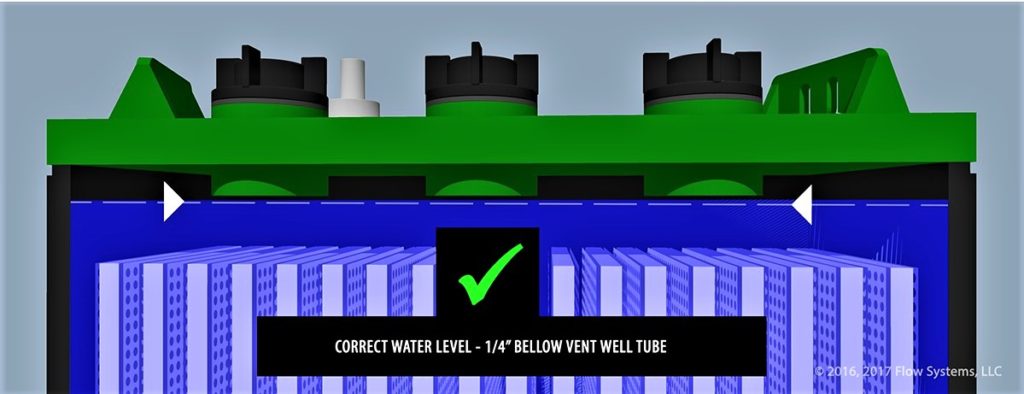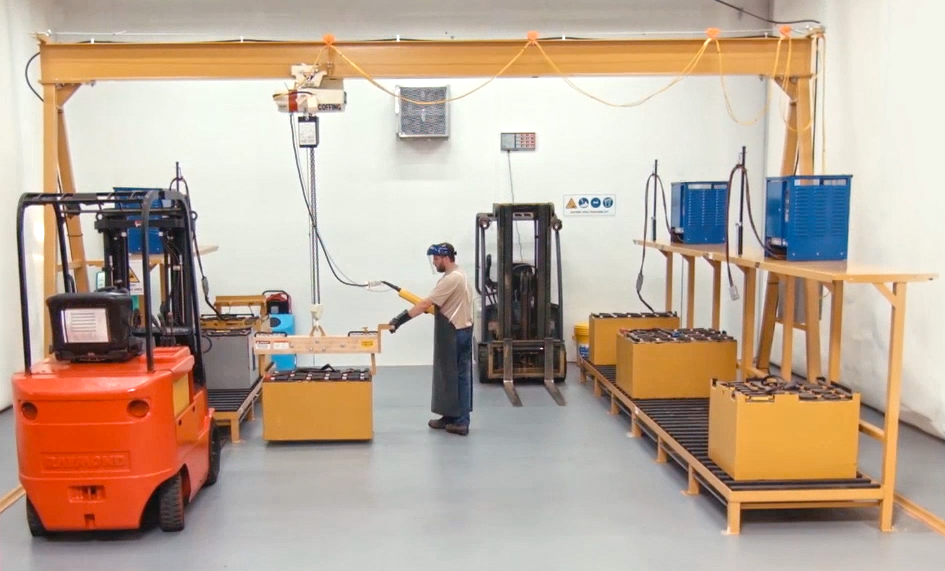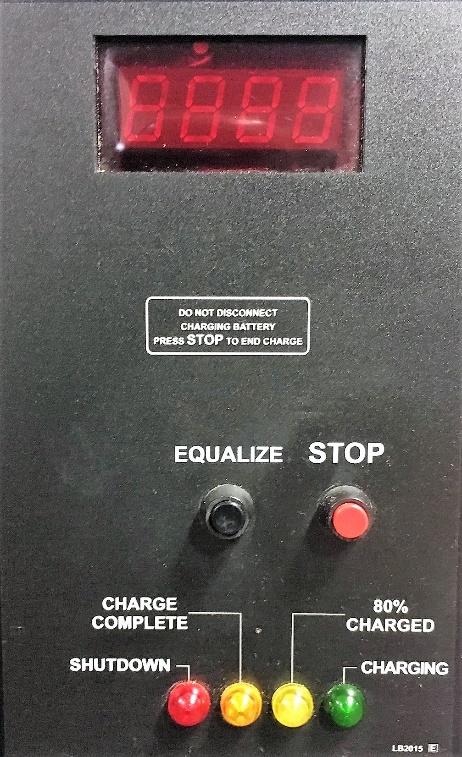Forklift Batteries: What to do on Day 1
- July 26, 2019
- industry news
- Posted by pennwesthost
- Leave your thoughts
Receiving the Battery:
Upon receiving the battery inspect the battery immediately for any signs of damage that might have occurred while in transit. Look for broken or missing blocking boards that keep it upright and prevent it from shifting on the pallet. Broken or missing boards may indicate that the battery may have tipped over and a closer inspection should be performed. Wet spots on the top and the sides of the battery generally indicate that the battery has been tipped over and there may be some electrolyte loss and internal damage. Any damage or electrolyte loss should only be corrected by a qualified battery repair person. Contact your servicing dealer as soon as possible.
Important!
Upon receiving the battery make sure that if there is evidence that the battery was damaged in transit be sure to make note of it on the shipping papers. Keep in mind that if you sign the papers receiving the damaged battery you will responsible for filing the freight claim with the carrier. Depending on the extent of the damage you may wish to refuse the delivery and the battery will be returned to and the claim filed by Crown Battery. Some damage done in transit can cause serious internal problems that will affect the overall performance and battery life.
After the battery has been received and there are no visible signs of damage. The battery should be given a freshening charge bringing the battery to a fully charged condition before placing it into service. It will usually take up to 3 hours at the finish rate to bring the battery to a fully charged condition. If your charger is equipped with AUTO/Start/Stop function use the equalize mode and give the battery an equalizing charge. When completed the charger will automatically shut down terminating the cycle.
Battery Water Level:
The battery was shipped with the correct electrolyte level from the factory. The electrolyte levels may settle during shipping causing variances in the levels when visually inspected. Do Not add water until after the battery has been fully given a freshening charge. After the freshening charge inspect the water levels and make sure that they water is at a level of ¼” above the splash plate which covers the cells. If not, then carefully add water but do not overfill. Simply make sure the water covers the separator protector.

Installation Procedures:
Your forklift battery will be very heavy averaging 1,000 to up to 5,000lbs. Installing the battery into the forklift will require an additional forklift or crane equipped with a lifting beam.
Typically, there are two methods top installation or side installation.


The battery should fit within the compartment of the forklift. If there is additional space, the area should be blocked to keep the battery from sliding or moving in the compartment.
Note: The weight of the battery is stamped on the battery case. It is imperative that the battery meet or exceed the minimum battery weight specified on the forklift.
The battery must be charged on a battery charger that matches the battery voltage and the amp hour rating. If you need assistance contact your local Crown Battery representative. Your battery is designed to provide power for your forklift for an 8-hour work shift. Of course there are variables in play as to how much you lift, travel etc. With a conventional charger your battery will require an 8-hour charge cycle and an 8 hour cooling cycle. Therefore, the typical application is 8 hours run time, 8 hours’ charge and 8 hours of cool down.
THINGS TO REMEMBER
Always allow the charger to complete the charge of the battery once it has started.
Make sure the charger is off or press the off button before disconnecting the battery.
Make sure your charger is regularly checked by a trained electrician or battery service technician.
TYPICAL CHARGERS CHARGER DISPLAY PANEL (1998 THRU PRESENT).

A typical charger that is within the age of 15 years old or less may have a typical display like this. L.E.D. Read out of Voltage, Amps Out, Avg. Volts per Cell along with Fault Codes. Review your manual. If you do not have a manual most models can be found on the internet.
Equalize Button and Stop Button. Simple to read indicator lights for current charging status. Your charger may be capable of programming items such as Time Delay Start, Automatic Equalization Charge.
Carefully review your manual and contact Pennwest for inspection, cleaning and maintenance.
It is normal for a battery charger to last for up to two life cycles of a battery. Well manufactured chargers will last from 10 to 20 years. It is important to keep the inside free of dirt and grime and have them checked usually twice a year to make sure they are at optimum performance. Chargers can undercharge or overcharge a battery without showing any fault codes. Also, the wires and connectors require a safety inspection.
BATTERY MAINTENANCE TIPS
Industrial batteries, like all pieces of industrial equipment, require proper maintenance to prolong their service life. Battery life is always extended when proper maintenance regimens are observed. On the other hand, poorly maintained and improperly used industrial batteries cannot perform to their full potential for the duration of the warranty period. Here are some “do’s and don’ts” of battery care for motive power battery users:
- Do maintain the proper electrolyte (acid) level by frequent additions of water. In general, normal city water will suffice, but if the end user has any doubts about purity of the local water supply, contact the battery supplier who will be happy to do a chemical analysis of the water. If in doubt, use distilled water.
- Don’t—that is NEVER—add sulfuric acid to the battery. If an acid spillage occurs, contact a qualified battery repair service.
- Do read the instructions provided with the battery on proper recharging of the battery. Automatic, voltage-controlled chargers will take the guesswork out of charging and there are several types available in the marketplace.
- Don’t try to save money by buying a charger which is smaller than required. This will result in an undercharged battery with significant reduction in operating life. Your battery vendor has all the information to ensure the battery and charger are precisely matched.
- Do check the charger settings and meters on a regular basis. This can be done by an in-house electrician, but should be performed every quarter by the battery service technician.
- Don’t overcharge the battery. More is not necessarily better when it comes to recharging batteries. The best way to ensure batteries are not being overcharged is to periodically (once a month) check the temperature of the center cell on a battery at the end of regular charge. If the temperature of the electrolyte is more than 36° F above the ambient temperature, call your battery technician— there is a problem.
- Do keep regular records on the maintenance of batteries. For instance, keep a log of every time the battery is watered; temperature checks at the end of charge, etc. These records will be invaluable when it comes to predicting when battery replacement is going to be necessary.
- Don’t over-discharge batteries. Most battery manufacturer’s warranty their batteries for up to 1.500 cycles of charge and discharge provided, among other things, that the battery is never discharged beyond 80%. This normally coincides with an eight-hour shift. But trucks fitted with extra equipment such as clamps, high speed lifts, etc. will need a higher capacity battery to ensure the battery is not discharged beyond 80%. Lift truck interrupts are available to detect the correct discharge level and are recommended by battery manufacturers as a means of ensuring batteries are not over-discharged.
- Do replace a battery with capacity that has fallen below 80% of its rated capacity. Continuing to operate the battery can be false economy since costly damage can be done to a truck’s electric motor and electronics.
- Don’t place metal objects on a battery. Such objects can cause a short circuit between adjacent cells and result in possible injury to those close to the battery. Similarly, people charged with caring for or operating batteries should not wear any metal jewelry.
- Do make regular inspections of every battery in the fleet and address problems of acid spillage and resulting corrosion immediately. Periodic (every three months) measurement and recording of the voltage and specific gravity of each cell in the battery will give early warnings of impending problems.
- Don’t underestimate the money a trained battery repair service can save you. They are the key to long, uninterrupted battery life and successful electric truck operation.
CLEANING AND MAINTAINING:
It is important that the top of your battery is kept clean and free of corrosion. Regular cleaning can reduce shorts and ground faults. The frequency depends on the environment you are operating in. Pennwest provides complete cleaning and inspection of your battery and charger. This minor investment can result in your battery providing peak performance well beyond the warranty period. We invite you to take a look at our services for both your battery and charger.

